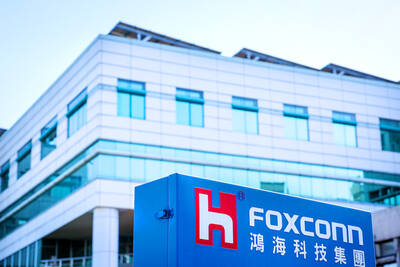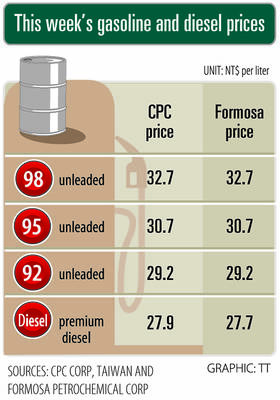The central bank might consider cutting interest rates this quarter if data due on Friday next week show that GDP growth was lower than 3 percent in the first half, economists said yesterday.
The Cabinet on Wednesday instructed the National Development Council to recommend measures to boost exports, which contracted 7.1 percent in the first six months, worse than the 6.95 percent fall the statistics agency projected in May.
The central bank was not a participant in the Cabinet’s discussions, but it might decide to step in and lower interest rates to help stimulate business activity, National Central University economics professor Hsu Chih-chiang (徐之強) said by telephone.
Low borrowing costs would encourage firms to increase the scope of their operations on credit and the negative consumer price index (CPI) reading also lends support to the case for monetary easing, Hsu said.
As of last month, the inflationary gauge had declined an average of 0.65 percent, dragged down by cheaper fuel prices, the Directorate-General of Budget, Accounting and Statistics said.
The agency is due to publish second-quarter GDP data on Friday next week. The figures showed a 3.37 percent increase in the first quarter.
“Poor exports raise alarms if they are not caused by declines in the price of crude,” Hsu said.
The Ministry of Finance has predicted a continued downturn in export data this quarter due to a high base in July and August last year.
Taiwan Semiconductor Manufacturing Co (TSMC, 台積電), the world’s largest contract chipmaker, last week gave a conservative guidance for business going forward, as inventory adjustments linger for its clients in emerging markets.
Against this backdrop, the central bank might cut interest rates by 12.5 basis points this and next quarter, HSBC Hong Kong-based economist John Zhu (朱日平) said.
The British banking group expects Taiwan’s exports to soften in coming months after export orders in May dropped 5.9 percent year-on-year — the fastest pace of decline in two years.
A strong New Taiwan dollar is adding to the challenges, with a 10 percent appreciation in its real effective exchange value this year, whereas central banks in the region have loosened their monetary policy, Zhu said.
Taiwan’s dependence on exports makes the economy susceptible to global cyclical volatility, and the government could shift the focus to domestic demand in a bid to revive the economy, Hsu said.
To that end, the government could increase investment by asking different agencies and state enterprises to upgrade their capital equipment, Zhu said.
For example, Taiwan Power Co (Taipower, 台電) could facilitate the installment of smart meters and smart grids nationwide, Hsu said.

Hon Hai Precision Industry Co (鴻海精密) yesterday said that its research institute has launched its first advanced artificial intelligence (AI) large language model (LLM) using traditional Chinese, with technology assistance from Nvidia Corp. Hon Hai, also known as Foxconn Technology Group (富士康科技集團), said the LLM, FoxBrain, is expected to improve its data analysis capabilities for smart manufacturing, and electric vehicle and smart city development. An LLM is a type of AI trained on vast amounts of text data and uses deep learning techniques, particularly neural networks, to process and generate language. They are essential for building and improving AI-powered servers. Nvidia provided assistance

GREAT SUCCESS: Republican Senator Todd Young expressed surprise at Trump’s comments and said he expects the administration to keep the program running US lawmakers who helped secure billions of dollars in subsidies for domestic semiconductor manufacturing rejected US President Donald Trump’s call to revoke the 2022 CHIPS and Science Act, signaling that any repeal effort in the US Congress would fall short. US Senate Minority Leader Chuck Schumer, who negotiated the law, on Wednesday said that Trump’s demand would fail, while a top Republican proponent, US Senator Todd Young, expressed surprise at the president’s comments and said he expects the administration to keep the program running. The CHIPS Act is “essential for America leading the world in tech, leading the world in AI [artificial

DOMESTIC SUPPLY: The probe comes as Donald Trump has called for the repeal of the US$52.7 billion CHIPS and Science Act, which the US Congress passed in 2022 The Office of the US Trade Representative is to hold a hearing tomorrow into older Chinese-made “legacy” semiconductors that could heap more US tariffs on chips from China that power everyday goods from cars to washing machines to telecoms equipment. The probe, which began during former US president Joe Biden’s tenure in December last year, aims to protect US and other semiconductor producers from China’s massive state-driven buildup of domestic chip supply. A 50 percent US tariff on Chinese semiconductors began on Jan. 1. Legacy chips use older manufacturing processes introduced more than a decade ago and are often far simpler than

Gasoline and diesel prices this week are to decrease NT$0.5 and NT$1 per liter respectively as international crude prices continued to fall last week, CPC Corp, Taiwan (CPC, 台灣中油) and Formosa Petrochemical Corp (台塑石化) said yesterday. Effective today, gasoline prices at CPC and Formosa stations are to decrease to NT$29.2, NT$30.7 and NT$32.7 per liter for 92, 95 and 98-octane unleaded gasoline respectively, while premium diesel is to cost NT$27.9 per liter at CPC stations and NT$27.7 at Formosa pumps, the companies said in separate statements. Global crude oil prices dropped last week after the eight OPEC+ members said they would